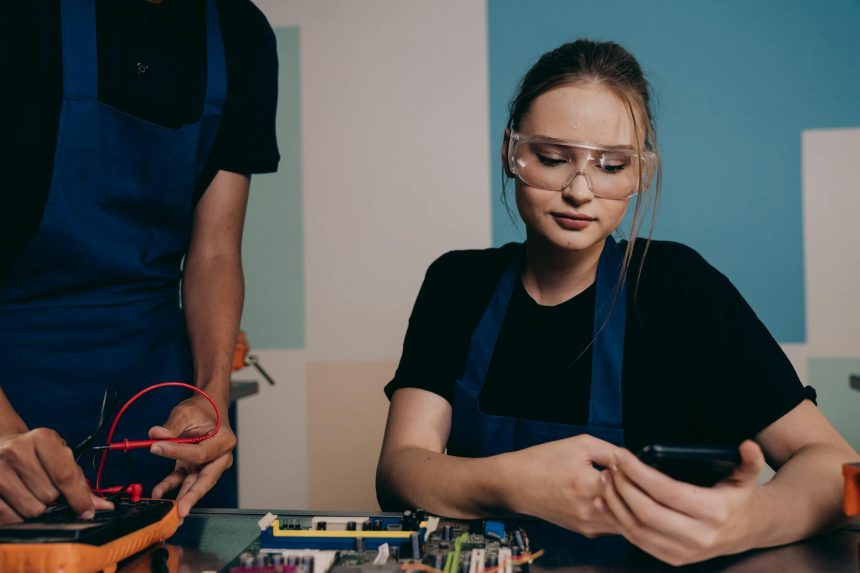vr-training-platform
VR Training Platform: 7 Ways Immersive Tech Boosts Trade Skills
Revolutionizing Apprentice Learning with Virtual Reality
Traditional methods for teaching critical trade skills, while foundational, often face significant hurdles. From the high cost of materials to inherent safety risks and limited access to specialized equipment, apprentices frequently encounter barriers to comprehensive, hands-on learning. Imagine a solution that overcomes these challenges, offering a safe, repeatable, and deeply engaging environment for skill development. This is where a cutting-edge VR training platform steps in, transforming how the next generation of skilled workers acquires essential expertise.
Why a VR Training Platform is a Game-Changer for Trade Skills
The landscape of vocational education is evolving rapidly, driven by technological advancements. Virtual reality offers an unprecedented opportunity to create immersive learning experiences that mirror real-world scenarios without the associated risks or expenses. This shift from theoretical instruction to practical, experiential learning is proving to be a powerful catalyst for change.
Addressing Traditional Training Challenges
For decades, apprentice training has relied heavily on physical tools, costly materials, and on-site supervision. While invaluable, this approach has its limitations:
- High Material Costs: Repeated practice often means significant material waste.
- Safety Concerns: Learning complex, dangerous tasks (e.g., welding, electrical work) always carries risk.
- Limited Accessibility: Not all apprentices have equal access to specialized equipment or experienced mentors.
- Inconsistent Instruction: Training quality can vary between instructors and locations.
A modern VR training platform directly addresses these issues, providing a consistent, safe, and scalable solution for workforce development.
The Power of Immersive Learning Environments
Virtual reality transports learners into a digital replica of a workshop, construction site, or factory floor. Within these immersive environments, apprentices can manipulate virtual tools, interact with machinery, and practice intricate procedures. This hands-on, risk-free practice builds muscle memory and confidence, preparing them for real-world application.
Key Benefits of a Modern VR Training Platform
The integration of virtual reality into vocational education offers a multitude of advantages that go beyond simple simulation. Here are seven transformative benefits:
- Enhanced Safety and Risk-Free Practice: Apprentices can practice dangerous tasks, such as operating heavy machinery or working with high voltage, in a completely safe virtual environment. Mistakes become learning opportunities, not costly or injurious errors.
- Accelerated Skill Acquisition: The ability to repeat tasks endlessly, receive immediate feedback, and focus on specific areas of weakness significantly speeds up the learning curve for complex trade skills.
- Cost Efficiency and Resource Optimization: By reducing the need for expensive physical materials, specialized equipment, and travel, VR training can dramatically cut operational costs while maximizing resource utilization.
- Improved Engagement and Retention: Immersive learning is inherently more engaging than traditional methods. The novelty and interactivity of VR keep apprentices motivated, leading to better knowledge retention and a deeper understanding of concepts.
- Standardized Training and Assessment: A VR platform ensures every apprentice receives the exact same high-quality instruction and is assessed against consistent metrics, ensuring a uniform skill level across the board.
- Accessibility and Remote Learning Opportunities: Geographic barriers dissolve as apprentices can access high-quality training from anywhere with an internet connection, broadening the reach of vocational education.
- Data-Driven Performance Insights: VR systems can track every action an apprentice takes, providing detailed analytics on performance, progress, and areas needing improvement. This data empowers instructors to tailor future training effectively.
Implementing Your Virtual Reality Training Platform
Adopting virtual reality for trade skill education requires careful planning and strategic integration. The success hinges on selecting the right tools and partners, alongside a thoughtful approach to curriculum development.
Choosing the Right Technology Partner
Selecting a developer with expertise in both VR technology and specific trade skills is crucial. Look for platforms that offer realistic physics, accurate tool replication, and customizable scenarios to meet your specific training needs. A robust VR training platform should be user-friendly for both instructors and learners.
Integrating VR into Existing Curricula
VR shouldn’t replace all traditional training but rather augment it. Successful integration involves identifying areas where VR can provide the most value – perhaps for initial safety training, complex procedure practice, or rare scenario simulations – and weaving it seamlessly into your current educational framework. For best practices in educational technology, consider resources like EDUCAUSE.
The Future of Workforce Development: Beyond the VR Training Platform
The impact of virtual reality on trade skills education is just beginning. As the technology matures, we can anticipate even more sophisticated simulations, integration with augmented reality for on-site assistance, and AI-powered adaptive learning paths. This evolution promises to create a highly skilled, adaptable workforce ready for the challenges of tomorrow.
Understanding the standards and best practices for emerging technologies in workforce training is essential. For more insights on technology standards and occupational safety, a valuable resource is the National Institute of Standards and Technology (NIST).
Conclusion: Embrace the Immersive Revolution
The advent of a sophisticated VR training platform represents a significant leap forward in how we prepare individuals for skilled trades. By offering unparalleled safety, efficiency, and engagement, virtual reality is not just enhancing training; it’s redefining it. The time to embrace this immersive revolution is now, ensuring apprentices are equipped with the skills and confidence needed to excel in their careers. Explore how virtual reality can transform your training programs today and empower the next generation of trade professionals.
Virtual reality headset person training trade skills construction welding factory
Featured image provided by Pexels — photo by Mikhail Nilov










